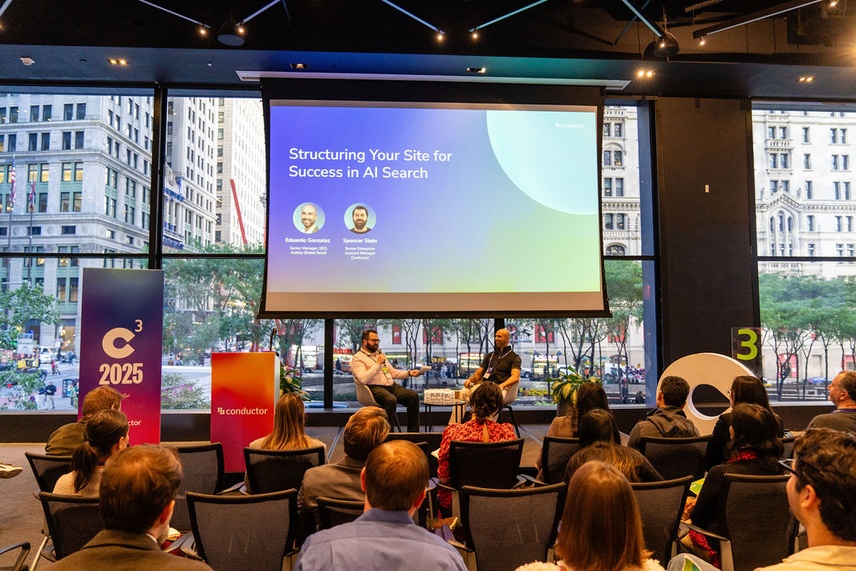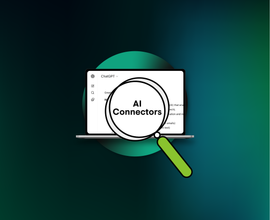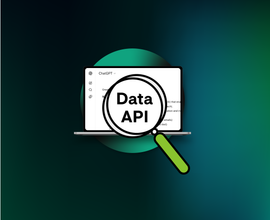Expert Tips: Structuring Your Site for AEO / GEO Success
AI search isn't just another algorithm update you can wait out—it's a permanent shift that's already changing how consumers find your content. Eduardo Gonzalez and Spencer Stein break down the technical fixes that actually move the needle and the monitoring strategies that help you stay ahead at scale. But here's the real game-changer: the teams winning in AEO / GEO have stopped letting internal assumptions drive their content strategy and started listening to what consumers actually need.
If you're ready to shift from "How do we rank?" to "How do we serve?"—and understand why that mindset is the key to earning citations—this recap is for you.
The way people find information online is changing fast. Answer engines like ChatGPT, Perplexity, and Google's AI Overviews don't rank pages—they cite sources. That fundamental shift changes how you need to structure your site. Success now depends on making your content technically accessible to AI crawlersCrawlers
A crawler is a program used by search engines to collect data from the internet.
Learn more and genuinely valuable enough to earn citations.
In this session from C3 2025, New York’s premier AEO / GEO conference, brought to you by Conductor, Eduardo Gonzalez, Senior Manager of SEO at Ashley Furniture Global Retail, and Spencer Stein, Principal Account Manager at Conductor, break down what's working for AI visibility and what's killing it.
Here are the technical and strategic shifts necessary to maximize visibility in order for AI systems—not just traditional search engines—to discover and surface your content:
- Fix crawlability first: Many sites accidentally block AI crawlers through robots.txt or aggressive bot detection, making them invisible to ChatGPT, Perplexity, and AI Overviews.
- Schema is non-negotiable: Structured data helps AI systems understand and cite your content. Broken or missing schema kills your discoverability.
- Monitor citations, not just rankings: Track how often AI systems reference your brand. Citation frequency is the new metric that matters.
- Remove internal bias from content strategy: Use external signals like reviews, social conversations, and actual search behavior to guide what you create, not internal assumptions.
- AI rewards genuine value: You can't trick AI systems into viewing you as authoritative. You earn authority by meeting user needs first.

Why AI search is different—and where most sites fail
AI search isn't another algorithm update that will stabilize in a few months. It represents a fundamental shift in how search works—from keywordKeyword
A keyword is what users write into a search engine when they want to find something specific.
Learn more matching to semantic understanding, from rankingsRankings
Rankings in SEO refers to a website’s position in the search engine results page.
Learn more to citations, from blue links to conversational answers.
This shift has elevated SEO and site structure from technical concerns to boardroom priorities:
We've had CEOs of Fortune 500 companies join trainings—that never used to happen, to be frank. I think it's about adapting how you take your priorities and using that newfound enthusiasm.
The executive-level attention signals that AI search isn't a side project; it’s a strategic imperative requiring investment and organizational buy-in—and the urgency is justified.
Sites that don't adapt their technical infrastructure and content approach won't just lose rankings—they'll disappear from AI-generated answers entirely. Most sites are already making critical mistakes that kill their AI discoverability before it even starts.
The four critical mistakes killing AI discoverability
Most sites aren't ready for AI search, and it's not because they're missing advanced optimizations. They're failing at the fundamentals. The same critical mistakes show up repeatedly in large eCommerce audits—and every one of them blocks AI systems from discovering and citing content.
Mistake #1: Blocking LLM crawlers
Many websites have inadvertently blocked the very bots that power AI search systems. Whether through robots.txt configurations, overly aggressive bot detection systems, or outdated technical implementations, these sites are invisible to the large language models that generate AI search results. Companies desperately want visibility in ChatGPT, Perplexity, and Google's AI Overviews—but they've locked the front door.
Mistake #2: Non-indexed landing pages
If a page isn't indexed by traditional search engines, it certainly won't be referenced by AI systems. This is an all-too-common occurrence in eCommerce sites: critical product landing pages, category pages, or seasonal campaign pages that never make it into the index. Sometimes, it's due to thin content, duplicate contentDuplicate Content
Duplicate content refers to several websites with the same or very similar content.
Learn more issues, or technical barriers like JavaScript rendering problems.
The result is the same: invisibility. If Google can't find it, AI systems definitely can't.
Mistake #3: Lack of structured data
Structured dataStructured Data
Structured data is the term used to describe schema markup on websites. With the help of this code, search engines can understand the content of URLs more easily, resulting in enhanced results in the search engine results page known as rich results. Typical examples of this are ratings, events and much more. The Conductor glossary below contains everything you need to know about structured data.
Learn more, the code that explicitly tells search engines what your content means, is absent from vast swathes of the web. For AI systems trying to understand your content at scale, this is like reading a book without chapter titles, headers, or a table of contents. The information might be there, but extracting and contextualizing it becomes exponentially harder.
Mistake #4: Invalid schema markup
Perhaps worse than no schema at all is broken schema. Invalid markup sends incorrect signals, creates confusion about what your content represents, and can actively harm your visibility. Common culprits include outdated schema types, incorrect property values, missing required fields, or markup that doesn't match the actual page content.
These aren't new problems, but the stakes have changed. In traditional search, these issues might cost you ranking positions. In AI search, they mean total invisibility.
Eduardo Gonzalez and Spencer Stein shared these insights and more during their C3 2025 session, Structuring Your Site for AI Search—watch the full recording below.
Technical optimizations that actually move the needle
Once you've fixed the foundational issues blocking AI discoverability, the next step is implementing strategic schema markup. For eCommerce and retail brands especially, these technical optimizations dramatically improve how AI systems discover, understand, and cite your content.
Leverage content-focused markup for rich results
Three schema types deliver outsized value for AI search visibility:
- FAQ schema structures common questions and answers directly on your pages. This isn't just good for traditional rich results—it's perfectly formatted for AI systems that need clear, concise answers to surface in conversational responses.
- How-to schema works particularly well for product pages with installation instructions, usage guides, or tutorials. When someone asks an AI system how to assemble furniture or use a product feature, properly marked-up How-to content becomes highly citable.
- About schema helps establish brand authority and context. It tells AI systems who you are, what you do, and why you're a credible source—critical for earning citations in competitive spaces.
The key insight: schema isn't just metadata for metadata's sake. It should enhance and clarify the on-page copy you've already created. Think of it as giving AI systems a reading guide for your content.
Maintain real-time eCommerce accuracy
For retail and eCommerce sites, product schema must be dynamic, not static. Three elements are non-negotiable:
- Pricing data must reflect current prices. Outdated pricing information doesn't just frustrate users; it erodes trust with AI systems that verify information across multiple sources.
- Availability status needs real-time updates. In-stock, out-of-stock, pre-order status—all of this should be accurate to the minute, not the week.
- Product specifications, such as colors, sizes, materials, and dimensions, must be current and comprehensive. Incomplete product data means incomplete citations.
The challenge here is greater than it seems. There’s a crucial distinction between traditional search and AI systems:
We got used to Google—they might not be perfect or work with you in the way that they used to 10 years ago. We got used to being able to edit Google My Business if the hours or location were incorrect. Meanwhile, with LLMs like ChatGPT, it's more of the wild west.
With Google My BusinessGoogle My Business
Google My Business is a product by the Google search engine.
Learn more, fixing an error takes minutes. With LLMs that have already been trained on incorrect information? The process is opaque, slow, and often impossible. Accuracy upfront is the only viable strategy.
Check out our latest article to learn how to adapt your holiday SEO strategies—and which technical optimizations to prioritize—for increased AI search visibility during peak shopping holidays like Black Friday and Cyber Monday.

Optimize for local with geo-coordinates and hours
For brands with brick-and-mortar locations, two schema types are essential:
- Geo-coordinate schema provides precise latitude/longitude data for every store location. This goes beyond just an address—it's machine-readable location data that local search systems can process instantly.
- Hours schema should include not just standard operating hours, but also holiday hours, special event hours, and real-time updates for unexpected closures.
Together, these schemas significantly improve local search visibility. When someone asks an AI system, "furniture stores near me that are open now," your structured local data determines whether you appear in that answer.
Monitoring site health at scale
Every lean SEO / AEO / GEO team grapples with the same question: What site health signals should you be monitoring as AI search evolves? How do you stay on top of structural issues at scale?
The answer centers on two core principles: track what matters for AI visibility, and use platforms that consolidate information for efficiency.
AI-specific metrics: From rankings to citations
The traditional SEO KPIs—rankings, traffic, click-through rates—remain important but don't tell the AI story. The new metrics for AEO / GEO that leaders should be focused on are:
- Citation frequency: Where is your content being referenced by AI systems? Which pieces are being pulled into AI Overview results, ChatGPT responses, or other answer engines?
- AI Search Performance tracking: Monitor which content appears in AI-generated results and how often. This requires tools specifically built for AI search visibility.
- Blog content performance in AI contexts: Are your thought leadership pieces being cited as authoritative sources? Eduardo noted this specifically because blogs play an increasingly important role in establishing expertise.
The platform approach: Conductor Monitoring
Managing technical SEO at enterprise scale requires consolidation. Scattered tools and manual checks don't work when you're monitoring thousands of pages across multiple site sections. Lean teams need a centralized platform that brings all site health signals into one view—making it possible to spot issues quickly and communicate them to leadership.
There are many lean teams out there, which makes you think about efficiency. So we look to platforms like Conductor to ensure we have all that information in one spot—we can digest it and move it to leadership.
The capabilities that make this possible:
- Page segmentation groups and monitors critical page sets—product categories, top-converting pages, seasonal campaign pages—rather than trying to track every page individually. For eCommerce sites with thousands or tens of thousands of pages, segmentation is the only scalable approach.
- Overall health status dashboards provide at-a-glance visibility into site-wide issues. Instead of manual checks, teams get a centralized view of what's healthy and what needs attention.
- Core Web Vitals tracking monitors page speed, interactivity, and visual stability—all factors that affect user experience. AI systems are increasingly considering these signals when determining content quality.
- Automated segments for different verticals, page types, and priority levels ensure teams focus their effort where it matters most.
Using the tools at your disposal and setting them up correctly, just like SEO, will build a foundation for your reporting to ensure that you're getting the right results and the right information. It might take a little time, but setting up that foundation will set you up for success.
There are no shortcuts. The teams that invest properly in monitoring infrastructure are the ones that spot issues before they cascade into traffic losses.

A paradigm shift: Consumer intent over everything
Beyond the technical optimizations and monitoring strategies, there's a fundamental strategic shift required for AI search success. Many content teams still let internal stakeholders drive content strategy—what products to highlight, what features to emphasize, what messaging to use. That approach won't work in AI search.
From SEO to AEO: The three eras of content
Content strategy has evolved through three distinct phases:
- Era 1: Creating copy to rank. This was the keyword-stuffing era. Exact-match optimization, keyword density calculations, and algorithms that could be gamed. The goal was simple: appear on page 1 for your target terms.
- Era 2: Creating copy to appear in AIs. This is where many teams are right now. They've shifted from optimizing for Google's traditional algorithm to optimizing for AI Overviews, ChatGPT, and answer engines. But the fundamental orientation hasn't changed—it's still about gaming systems rather than serving users.
- Era 3: Creating content for consumer intent. This is the future and to some, the only sustainable approach for AEO / GEO and winning in AI search.
The future is all about intent searches. Before, we were just creating copy to rank; today, we're creating copy to appear in AIs. Think about the consumer. When you're doing your keyword research, what is that intent? Is it transactional, commercial, what is it? Feed your website what consumers are looking for. Take yourself and any internal perspective out of the equation and create content for the consumer
For many organizations, this is the most challenging transition to implement:
Understand consumer intent and client needs, not internal assumptions. Use external signals—what people say about your brand—to guide content strategy. Establish your brand as the authority by serving the consumer, then guiding crawlers to recognize that authority. Internal perspectives must be excluded.
What does this mean in practice?
- Stop letting product teams dictate content priorities based on what they want to sell rather than what customers want to know.
- Abandon internal jargon that makes sense in conference rooms but confuses actual customers.
- Listen to external signals, like social media conversations about your brand, customer support inquiries, product reviews, search behavior, forum discussions, and competitor mentions.
- Build authority through genuine service first, then let that authority signal to crawlers and AI systems. The sequence matters—you can't trick AI systems into thinking you're authoritative. You have to earn it by meeting user needs, and then ensure AI systems can see that you've earned it.
Why intent matters more in AI search
Traditional search engines could be manipulated. With enough technical SEO knowledge and backlinksBacklinks
Backlinks are links from outside domains that point to pages on your domain; essentially linking back from their domain to yours.
Learn more, you could rank for terms even if your content wasn't genuinely the best answer.
AI systems are harder to fool. They synthesize information from multiple sources, cross-reference claims, and evaluate coherence and authority at a more sophisticated level.
The bottom line? Citations are earned, not gamed.
As it pertains to AI, you think about the citations, right? Where are you appearing? What are you appearing for? That will dominate the future as we walk towards this new path.
The teams that win in AI search will be those that genuinely understand and serve their customers' needs. Everything else—the technical optimization, the structured data, the monitoring—is table stakes that enable AI systems to discover and cite valuable content.
Blogs as conversion engines
Blog content plays a different role in AI search than it did in traditional SEO.
Think of blogs as your new portal of conversion.
In AI search, the traditional awareness-to-conversionConversion
Conversions are processes in online marketing that lead to a defined conclusion.
Learn more funnel has collapsed. Blog content demonstrating expertise and serving user intent now drives both visibility and conversion. When AI systems cite your blog, prospects discover your brand and solutions simultaneously.
But this requires collaboration:
Partner with the powers that be on your team—creative and product—make friends with your product and development team, everyone, because those are the people who are really going to push that needle for you.
SEO teams can't execute AI strategies alone. Product teams control schema implementation, development teams manage infrastructure, and creative teams produce content. Leadership controls resources—and is now more engaged than ever, with CEOs attending SEO training.
The newfound C-suite interest creates opportunity, but only if SEO teams articulate value and collaborate effectively. For lean teams, these cross-functional relationships determine success.
In summary
AI search success requires both technical excellence and a consumer-first mindset. You can't trick AI systems into viewing you as authoritative. You earn authority by meeting user needs, then use structured data to help AI systems recognize what you've built.
The shift from "how do we rank?" to "how do we serve?" separates leaders from laggards. Citations—not rankings—dominate in AI search. And citations are earned through genuine value, not gaming algorithms.
Take yourself and any internal perspective out of the equation and create content for the consumer.
The action plan is clear: fix crawlability, implement strategic schema, monitor citation frequency, and remove internal biases from content strategy. AI search rewards technical excellence paired with genuine consumer focus.
This article is based on insights shared at C3—New York’s premiere AEO / GEO conference—brought to you by Conductor, and has been adapted for clarity and depth.

![Spencer Stein, Senior Enterprise Account Manager, [object Object]](https://cdn.sanity.io/images/tkl0o0xu/production/f3274e25800fa6aaac1563d7f2aed61f672a7fa5-3456x5184.jpg?fit=min&w=100&h=100&dpr=1&q=95)
![Eduardo Gonzalez, Senior Manager, SEO, [object Object]](https://cdn.sanity.io/images/tkl0o0xu/production/01a2067223217b90c9403ac9cb25e37195505bcd-3483x4354.jpg?fit=min&w=100&h=100&dpr=1&q=95)






